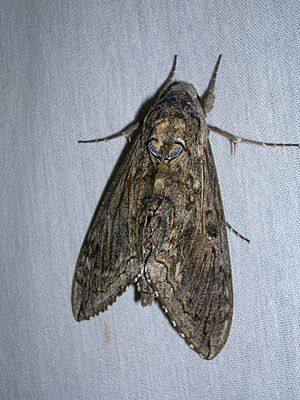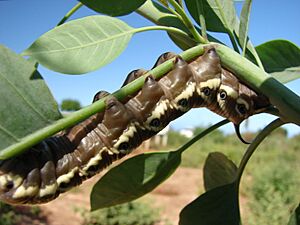Hawaiian tomato hornworm facts for kids
Quick facts for kids Hawaiian tomato hornworm |
|
|---|---|
 |
|
 |
|
| Conservation status | |
 Critically Imperiled |
|
|
LE
|
|
| Scientific classification | |
| Synonyms | |
|
The Manduca blackburni, also called the Hawaiian tomato hornworm or Blackburn's sphinx moth, is a type of moth. It is part of the Sphingidae family, which includes many large moths. This special moth is very rare and lives only in Hawaii.
Contents
About the Hawaiian Tomato Hornworm
The Hawaiian tomato hornworm looks a lot like the common tomato hornworm. They are very closely related. A scientist named Arthur Gardiner Butler first described this moth in 1880.
Where This Moth Lives
This moth is endemic to Hawaii. This means it is found naturally nowhere else in the world. It used to live on all the main Hawaiian islands. But now, it is only found on Maui, the Big Island, and Kahoʻolawe. You can find it in forests near the coast and in dry forests. These areas can be from sea level up to about 1,500 meters (5,000 feet) high.
What They Eat
The young moths, called larvae or caterpillars, eat plants from the nightshade family. Their favorite food is a native Hawaiian plant called ʻaiea. They also eat other plants like non-native tomatoes, tobacco, tree tobacco, jimson weed, and eggplant.
Adult moths drink nectar from flowers. They like native Hawaiian plants such as koali ʻawa and maiapilo.
Protecting the Hawaiian Tomato Hornworm
The Hawaiian tomato hornworm is an endangered species. This means it is at high risk of disappearing forever. The United States Fish and Wildlife Service listed it as endangered in the year 2000. It was the first insect from Hawaii to get this important protection. A group called NatureServe also says this insect is "Critically Imperiled." This means it is in extreme danger.

